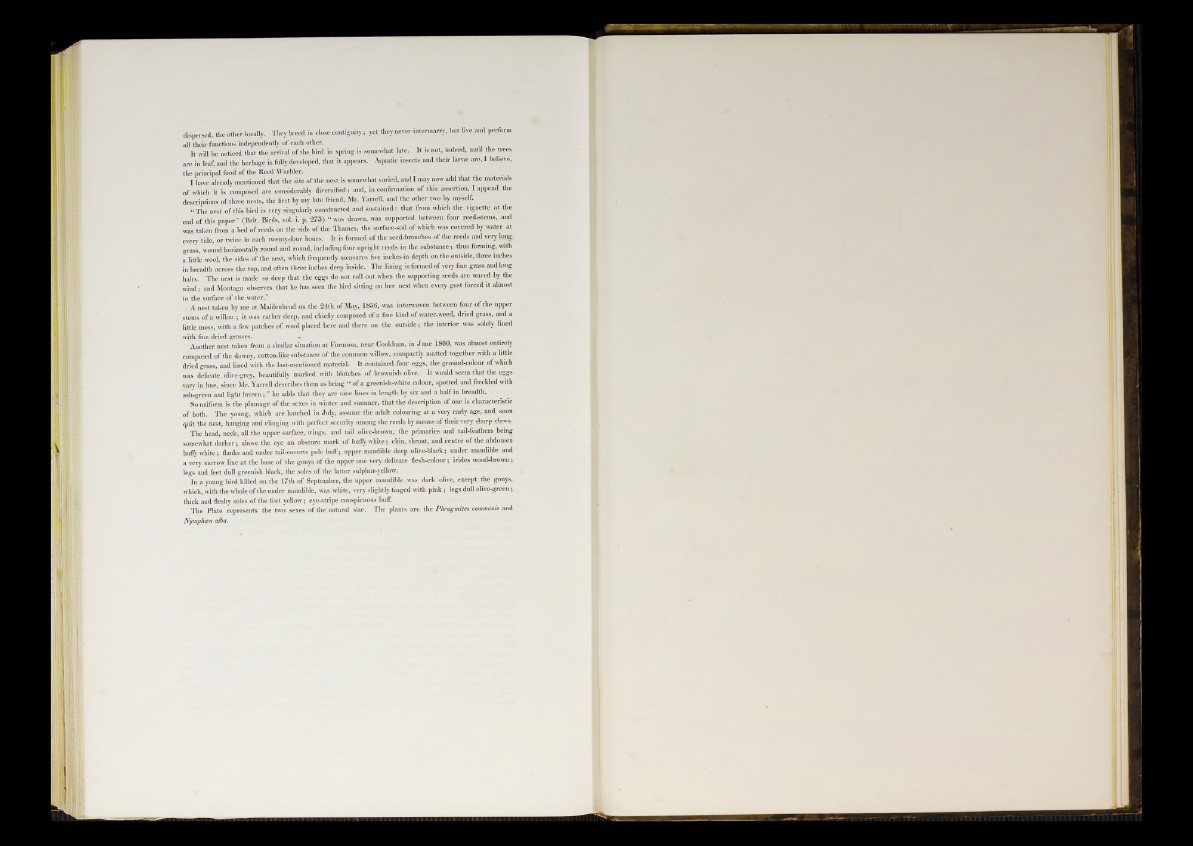
dispersed, the.other locally. They breed to close contiguity; yet they never intermarry, but live and perform
all their functions independently of each other.
It will be noticed tbat the arrival of the bird in spring is somewhat late. It is not, indeed, until the trees
are in leaf, and the herbage is fully developed, that it appears. Aquatic insects and their larv» are, I believe,
the principal food of the Reed Warbler.
I have already mentioned that the site of the nest is somewhat varied, and I may now add that the materials
of which it is composed are considerably diversified; and, in confirmation of this assertion, I append the
descriptions of three nests, the first by my late friend, Mr. Yarrell, and the other two by myself.
“ The nest of this bird is very singularly constructed and sustained: that from which the vignette at the
end of this paper" (Brit. Birds, vol. i. p. 273) "was drawn, was supported between four reed-stems, and
was taken from a bed of reeds on the side of the Thames, the surfiice-soil of which was covered by water at
every tide, or twice in each twenty-four hours. It is formed of the seed-branches of the reeds and very long
grass, wound horizontally round and round, including four upright reeds in the substance; thus forming, with
a little wool, the sides of the nest, which frequently measures five inches in depth on the outside, three inches
in breadth across the top, and often three inches deep inside. The lining is formed of very fine grass and long
hairs. The nest is made so deep that the eggs do not roll ont when the supporting reeds are waved by the
wind; and Montagu observes that.he has seen the bird sitting on her nest when every gust forced it almost
to the surface of the water.”
A nest taken by me at Maidenhead on the 24th of May, 1856, was interwoven between four of the upper
stems of a willow; it was rather deep, and chiefly composed of a fine kind of water-weed, dried grass, and a
little moss, with a few patches of wool placed here and there on the outside; the interior was solely lined
with fine dried grasses.
Another nest taken from a similar situation at Formosa, near Cookbam, in June 1860, was almost entirely
composed of the downy, cotton-like substance of the common willow, compactly matted together with a little
dried grass, and lined with the last-mentioned material. It contained four eggs, the ground-colour of which
was delicate olive-grey, beautifully marked with blotches of brownish olive. It would seem that the eggs
vary in hue, since Mr. Yarrell describes them as being “ of a greenish-white colour, spotted and freckled with
ash-green and light brown ; ” he adds that they are nine lines in length by six and a half in breadth.
So uniform is the plumage of the sexes in winter and summer, that the description of one is characteristic
of both. The young, which are hatched in July, assume the adult colouring at a very early age, and soon
quit the nest, hanging and clinging with perfect security among the reeds by means of their very sharp claws.
The head, neck, all the upper surface, wings, and tail olive-brown, the primaries and tail-feathers being
somewhat darker; above the eye an obscure mark of bufly w hite; chin, throat, and centre of the abdomen
bufly white; flanks and under tail-coverts pale buff; upper mandible deep olive-black; under mandible and
a very narrow line at the base of the gonys of the upper one very delicate flesh-colour; ¡rides wood-brown ;
legs and feet dull greenish black, the soles of the latter sulphur-yellow.
In a young bird killed on the 17th of September, the upper mandible was dark olive, except the gonys,
which, with the whole of the under mandible, was white, very slightly tinged with p ink; legs dull olive-green;
thick and fleshy soles of the feet yellow; eye-stripe conspicuous buff.
The Plate represents the two sexes of the natural size. The plants are the Phragmites communis and
Nymphaea alba.